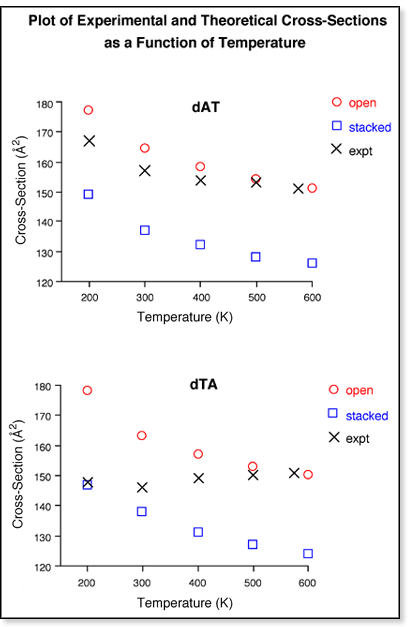|
Dinucleotides
- High-Temperature Results
 A
plot of experimental cross section vs. temperature is shown at right for
dAT and dTA. The 80 K ATDs for dAT and dTA show two peaks that correspond
to the stacked and open conformers. The collision cross
sections obtained from the two peaks are identical for each dinucleotide
(the increase in cross section below 300 K is due to the ion-He interaction
potential [Wyttenbach, T.; von Helden, G.; Batka, Jr., J.J.; Carlat, D.;
Bowers, M.T. J.
Am. Soc. Mass Spectrom. 1997, 8, 275-282]). However,
the stacked conformer is the dominant (90%) form of dTA but the
open conformer is the dominant (95%) form of dAT. By 200 K, the
two conformers isomerize, yielding one peak in the ATD and one averaged
collision cross section. A
plot of experimental cross section vs. temperature is shown at right for
dAT and dTA. The 80 K ATDs for dAT and dTA show two peaks that correspond
to the stacked and open conformers. The collision cross
sections obtained from the two peaks are identical for each dinucleotide
(the increase in cross section below 300 K is due to the ion-He interaction
potential [Wyttenbach, T.; von Helden, G.; Batka, Jr., J.J.; Carlat, D.;
Bowers, M.T. J.
Am. Soc. Mass Spectrom. 1997, 8, 275-282]). However,
the stacked conformer is the dominant (90%) form of dTA but the
open conformer is the dominant (95%) form of dAT. By 200 K, the
two conformers isomerize, yielding one peak in the ATD and one averaged
collision cross section.
Between
200 and 400 K, the experimental cross section for dAT is larger than that
of dTA. This is due to the fact that even though the stacked and
open conformers are isomerizing in the drift cell, the average
drift time is weighted by the relative amounts of each conformer. The
dinucleotide dAT, with a high percentage of open conformers will
therefore have a larger average cross section than dTA, which has a high percentage of the smaller stacked conformers.
However, between 400 and 600 K, the experimental cross sections of dAT
and dTA merge to the same value.
dTA, which has a high percentage of the smaller stacked conformers.
However, between 400 and 600 K, the experimental cross sections of dAT
and dTA merge to the same value.
The plots
at left compare the experimental cross sections to values calculated for
the theoretically determined open and stacked dinucleotide
structures. For dAT, the experimental cross section agrees well with the
theoretical value of the open form from 200 to 600 K. For dTA,
the experimental cross section agrees well with the theoretical value
of the stacked form between 200 and 300 K but begins to agree with
the open form between 400 and 600 K. This indicates that the dTA
are "opening up" at higher temperatures, favoring the open
forms. In fact, all of the dinucleotides that favored the stacked
or H-bonded forms at lower temperatures "opened up" between
400 and 600 K.
|

